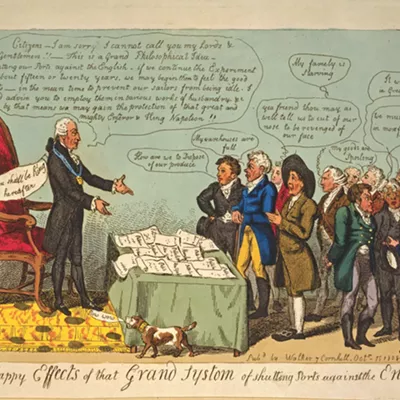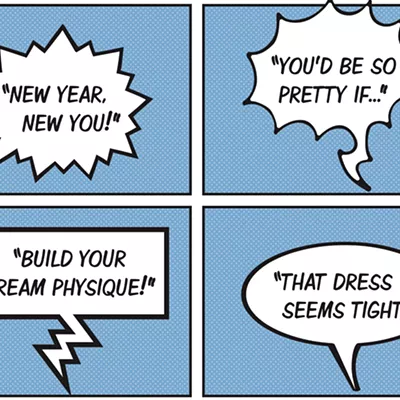First, they put her in a glass case. The one up front, right beneath the register. Her black hair was split into two braids and placed over her shoulder; pony beads fastened the ends. Feathers on strands of faux leather were glued to her hair. More pink and blue pony beads on the headband that haloed her head, her bangs, cut high on her forehead, seemed in constant rebellion to the forced regalia. The dress put on her was crocheted. Blue and red trim on ruffles of cream. Silver plated conchos. She stood with the help of a white metal doll stand, though both tilted slightly to the left. Her feet were bare, a red lipped smile was painted permanently on her sharp featured face. Her eyes were brown with a sweep of blue eyeshadow.
Stuck atop her right foot, a price: $7.99.
In the 1960s and early '70s when companies such as Fibre Craft were producing these 11-inch dolls for U.S. women to adorn with synthetic yarn, Native American women were being sterilized by the thousands.
In a program initiated by the Indian Health Service, physicians were encouraged to perform sterilizations in the form of tubal ligations and hysterectomies on Native women — often without their consent. Some figures estimate that at least 70,000 Native women were sterilized during the 1960s and '70s. The youngest was 11 years old. A poll taken by Northern Cheyenne tribal judge Maria Sanchez revealed the stories of two 15-year-old girls who were told they were having their tonsils taken out but returned from the hospital without ovaries.
Between 1969 and 1974, the Department of Health Education and Welfare increased its family planning budget, which included funding for abortions and sterilization, from $51 million to more than $250 million.
The next week I am back at the secondhand store. I find the doll sitting on a shelf with children's toys. On her left a stuffed Shrek, leaning on her right arm an action figure. A woman comes up beside me to look at the doll. "My husband just loves to collect Native things," she says reaching for the doll. The woman grabs her, lifting the dress and examining her naked legs, torso. "I wonder if she is worth more than they think."
The Fibre Craft dolls, with or without their handmade clothes, never became collectible. Other dolls from the era, those with porcelain faces or eyes that closed when they were reclined, sell for anywhere from $16 to $650 dollars or more on eBay and Etsy. Sellers use words and phrases such as: Vintage, Highly Collectible, One-of-a-Kind, Unique, Like New.
And as the bids for dolls rise, Indigenous female bodies continue to disappear. In 2016, the FBI's National Crime Center pegged the number of missing Native American and Alaska Native women and girls at 5,712. An undoubtedly low figure.
For the next two days I worry about the fate of the doll. Is she better with some so-called collector, or as a child's plaything? Should I buy her? Redress her? Pull her from the shelf and silently return her in a pant suit? Maybe I should leave her on my desk as a reminder of a society that has objectified Native women and of non-Native women and companies that have appropriated culture and dress for commerce or play. Perhaps the right answer is to remove her from the public eye, because to let her sit is to let that same eye hold all Native women in a historical place, just as the stand holds her by the neck.
When I finally decide what to do, it is too late. I return to the store and find her gone from the shelf, a panting pink Beanie Baby puppy in her place. I ask the cashier if she was sold. "I don't think so," she answers, "that doll had been here forever."
"What happened? Where is she?"
"Probably got re-donated. Maybe someone else will get a couple bucks for her." ♦
CMarie Fuhrman is the author of Camped Beneath the Dam: Poems (Floodgate 2020) and co-editor of Native Voices (Tupelo 2019). She has published poetry and nonfiction in multiple journals as well as several anthologies. She resides in the mountains of west-central Idaho.





















